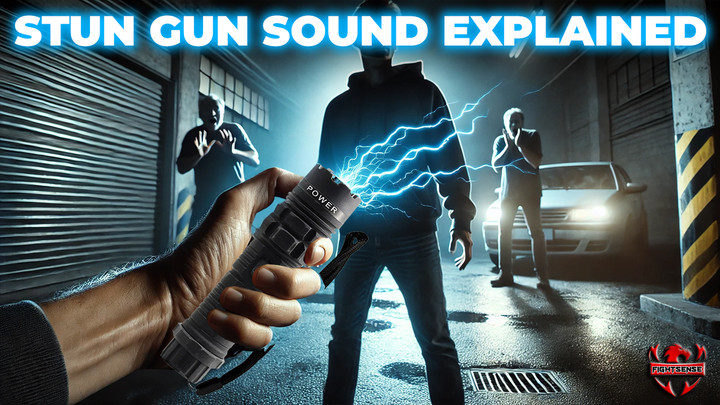Stun Gun Sound Explained: Power, Safety & Myths
24th Feb 2025
A stun gun is one of the most effective self-defense tools, and its signature crackling sound is more than just noise—it’s a warning, a deterrent, and a reflection of its power. When you activate a stun gun, the sharp electrical burst makes an attacker think twice. But what exactly does the stun gun sound indicate? How does it differ between models? And why is it essential in real-world defense situations? This guide breaks down everything you need to know.
Key Highlights
-
The stun gun sound is an audible warning sign of its power and effectiveness.
-
Higher voltage stun guns produce a louder, sharper sound as a psychological deterrent.
-
Different stun gun models emit varying sound intensities, impacting their real-world use.
-
The sound alone can often prevent an attack, reducing the need for confrontation.
-
Always test your stun gun to ensure optimal performance before carrying it for self-defense.
Understanding the Science Behind the Stun Gun Sound
The stun gun sound is produced when high-voltage electricity arcs between two electrodes, creating a visible spark and a crackling noise. The intensity of the sound depends on:
-
Voltage Output: Higher voltage stun guns produce a louder, sharper sound.
-
Current Flow: The amperage determines the effectiveness of the shock.
-
Electrode Design: Larger electrode gaps often result in deeper and more aggressive sounds.
When used correctly, the sound alone can be a psychological deterrent, scaring off potential threats before physical contact is needed.
What Stun Gun Sound Says About Power & Performance
1. Low-Voltage Stun Guns: Subtle but Functional
-
Emit a softer, buzzing sound.
-
It is ideal for personal defense in close encounters.
-
Suitable for users seeking lightweight protection.
2. Medium-Voltage Stun Guns: A Balanced Approach
-
Produce a consistent crackling noise with a visible electric arc.
-
Strong enough to incapacitate an attacker momentarily.
-
It is best for individuals needing reliable protection without excessive force.
3. High-Voltage Stun Guns: Maximum Deterrence
-
Loud, intimidating electric bursts that echo power.
-
Designed for law enforcement and high-risk defense situations.
-
Ensures immediate impact upon contact.
The stun gun sound can be tested before use, allowing you to gauge its strength and effectiveness in real time.
How Different Stun Guns Compare in Sound & Power
| Stun Gun Type | Sound Intensity | Best For | Effectiveness |
|---|---|---|---|
| Mini Stun Gun | Soft, buzzing | Everyday self-defense | Moderate |
| Flashlight Stun Gun | Crackling, sharp | Tactical and multi-purpose use | High |
| Heavy-Duty Stun Gun | Loud, aggressive | Law enforcement & extreme threats | Maximum |
| Keychain Stun Gun | Mild to moderate | Discreet protection | Moderate |
| Tactical Stun Gun | Very loud, intimidating | Ultimate defense & deterrence | Maximum |
Common Myths About Stun Gun Sound
Myth 1: A Louder Stun Gun Is Always More Powerful
Not necessarily. Some stun guns may have an amplified sound but deliver less stopping power. Always check the voltage and amperage.
Myth 2: All Stun Guns Sound the Same
Each model has a unique frequency and intensity, depending on build quality and voltage level.
Myth 3: Stun Guns Don’t Work If They’re Quiet
Even a soft hum can deliver a powerful shock if the amperage is sufficient.
Shop Now !
Final Thoughts
In essence, the distinctive crackling of a stun gun is more than mere noise—it’s an audible manifestation of its defensive power. Serving as both a deterrent and a performance indicator, its intensity varies across models, influencing real-world effectiveness.
While a louder sound often signals higher voltage, true stopping power depends on amperage and build quality. Understanding these nuances allows users to make informed choices, ensuring they wield a device that aligns with their self-defense needs. Ultimately, the stun gun’s sound alone can be enough to thwart threats, reinforcing its role as a vital, non-lethal protective tool.
FAQs About Stun Gun Sound
1. What does a stun gun sound like?
When activated, a stun gun emits a sharp, crackling noise, signaling high-voltage electricity arcing between electrodes.
2. Does the stun gun sound indicate its power?
Yes, to some extent. Louder stun guns typically indicate higher voltage, but amperage and overall build quality also play a role.
3. Can the sound alone deter an attacker?
Absolutely. Many attackers flee upon hearing the intimidating stun gun sound before any physical contact is needed.
4. Why do some stun guns sound louder than others?
The sound intensity varies based on voltage, electrode design, and current flow.
5. Can a stun gun still work if it makes a weak sound?
Yes, as long as the electrical current is strong enough to disrupt muscle function upon contact.
Disclaimer:
Stun gun laws vary by region. Ensure compliance with your local regulations before purchasing or using a stun gun. Use responsibly for self-defense only.

